Chapter 7 (Events of the earlier months of 1183)
7-[1] Shimizu no Kanja --- With this section, the exploits of Kiso no Yoshinaka become an important focus of the story.
Major characters
- Minamoto no Yoritomo, the general who is currently based in Kamakura and who will become the first shôgun
- Kiso no Yoshinaka of the Minamoto family line
- Minamoto no Yukiie, "our uncle" --- younger brother to the two men who are, respectively, Yoshinaka's and Yoritomo's fathers.
- Shimizu no Kanja Yoshishige, the 11-year old heir of Yoshinaka, then adopted by Yoritomo
Section Summary
- Yoritomo does not trust Yoshinaka and prepares an attacking force. To gain allegiance, or time --- however you wish to read it --- Yoshinaka sends Yoritomo, his 11-year old heir, whom Yoritomo, heirless, adopts.
7-[2] The Expedition to the Northern Provinces --- The Taira's response to the growing power of Yoshinaka and Yoritomo.
Section Summary
- The Taira unleash a punitive force northward to first defeat Kiso no Yoshinaka, then Yoritomo. These 100,000 men, however, pillage along the way the commoners in order to support their force, acts sanctioned by the Taira clan.
7-[3] The Visit to Chikubushima --- An artistic respite from the story's fights.
Major characters
- Koremori, Shigemori's eldest son. He did not, however, become clan head. (His uncle Munemori, Kiyomori's younger brother took that role.) In an early passage he was routed at the Battle of Fuji River. See Chapter Five, Section [11].
Section Summary
- Taira no Tsunemasa, a warrior with artistic sensibilities who takes a side trip to an island called Chikubushima. There he makes prayer, music and poetry.
Reading notes
- <226> "Mt. Hôrai" --- A fictional, fantastic island.
Multimedia
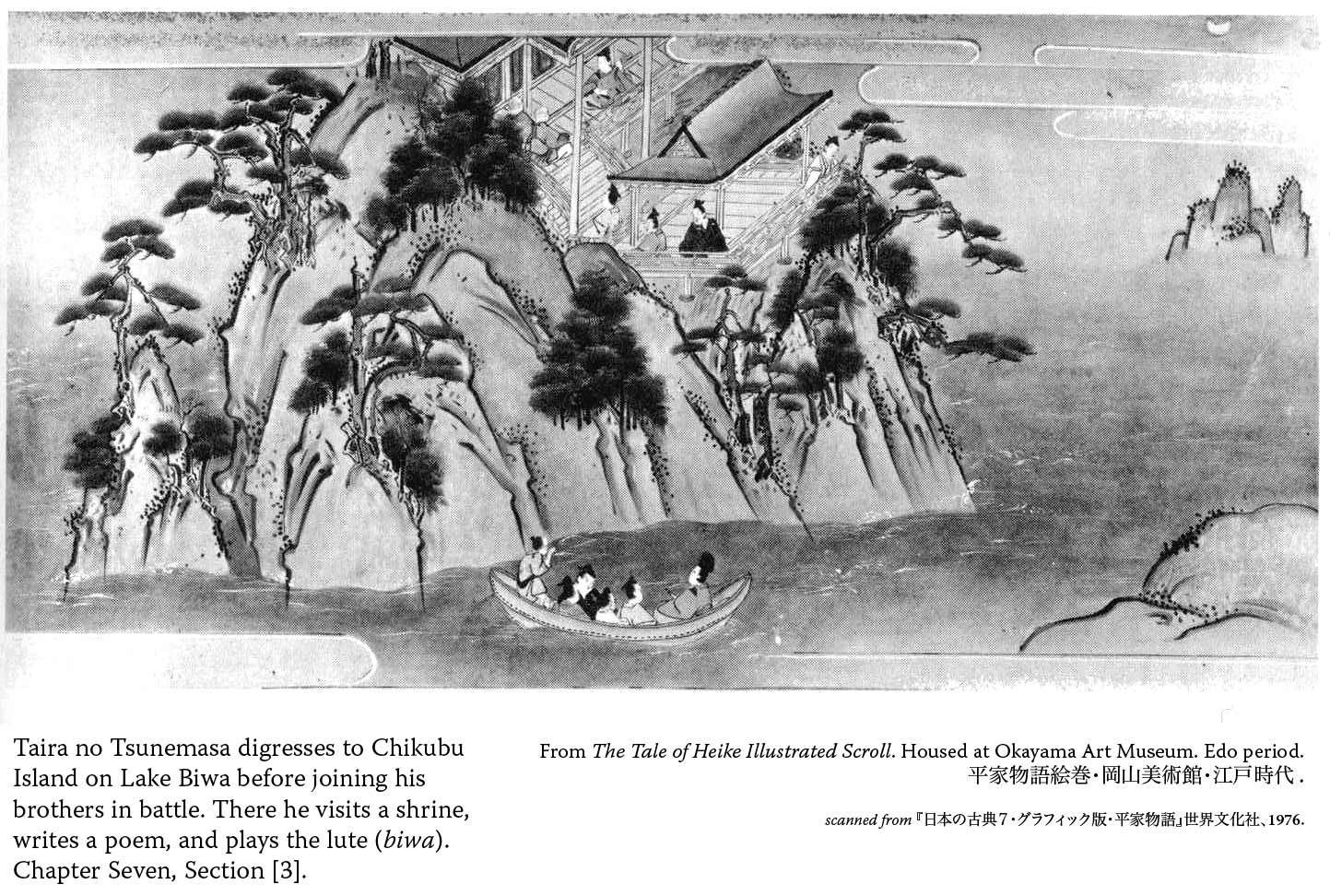
7-[4] The Battle at Hiuchi --- The Taira score an early victory against a Yoshinaka garrison.
Section Summary
- A portion of Yoshinaka's forces builds fortifications at Hiuchi, in Echizen, but the dam that was built to create a protective water barrier is broken apart by a betrayer in the ranks. The Taira make the water crossing en masse and easily overrun the defensive position.
- Yoshinaka sets out with a counter-attacking force, and makes a 7-pronged advance, for he believes this to be auspicious.
Reading notes
- <227> "whizzing arrow" --- A type of arrow with a bulbous end that is perforated so as to make noise when shot. It was used for ceremonial purposes. (Arrows, and twanging bows for that matter, that made noise were thought to be heard by gods and spirits.) Below is an example of some modern-day tips for such arrows. Also, here is a link to a Japanese language site on archery, which includes various pictures, including those below: http://www009.upp.so-net.ne.jp/yashi/
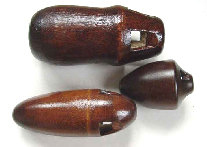
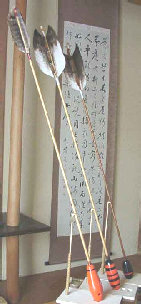
- <228> "In the belief that his earlier battle had set an auspicious precedent, he divided his army into seven groups "---This might refer to Chapter Six, Section [12] "The Battle at Yokotagawara" but it is not entirely clear; also, only six prongs of the attack are listed.
7-[5] The Petition --- A section devoted to describing Yoshinaka as a warrior who respects the gods. Also, it is his victory in the next section that marks the turning point in the road to defeating the Taira. Thus this is something of a pre-climax pause, or a religious climax if you wish to think of it in those terms.
Section Summary
- Kiso no Yoshinaka uses the strategy of positioning a large number of standard bearers at hilltops in order to fool the Taira into thinking his force is large.
- Before going into battle, Yoshinaka writes a prayer and offers it to the god Hachiman at a nearby shrine.
7-[6] The Descent into Kurikara --- Yoshinaka achieves a major military victory. The Taira forces are eviscerated (only 2,000 of the original 70,000 mustered survive the attack).
Major characters
Section Summary
- Yoshinaka makes a successful late-evening attack, descending the steep slopes of Kurikara Valley to attack the Taira from both the front and back. It is a serious defeat for the Taira.
- Yoshinaka then leaves to help Yukiie in his battle at Shio-no-yama, succeeding there as well.
Reading notes
- <230> "humming-bulbs" --- uwaya no kabura
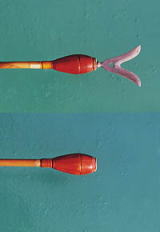
- <231> "streams of blood flowed from rocks" --- (literally, "cliff-springs of blood" gansen no chi) one of the rare mentions of blood drawn in battle
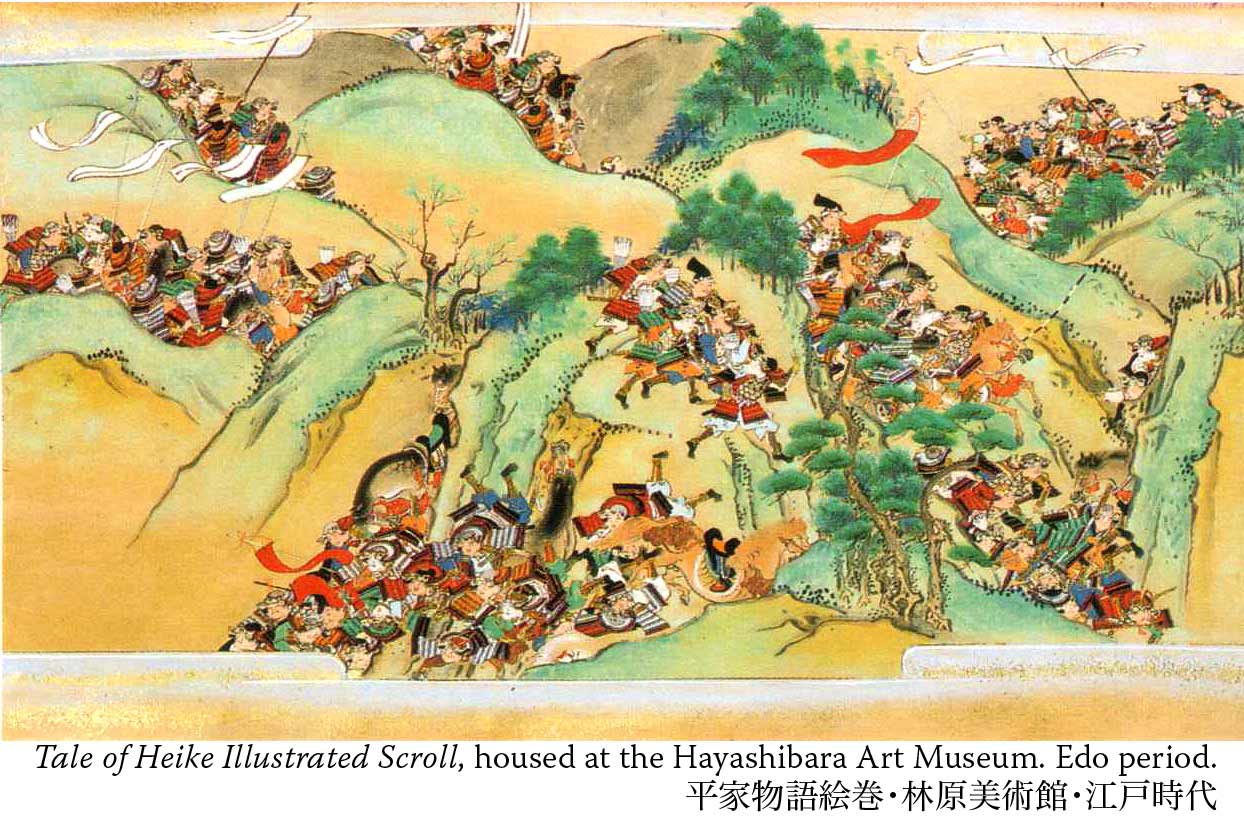
7-[7] The Battle at Shinohara --- A section emphasizing individual acts of bravery of warriors (from both sides) in battle, including introducing Sanemori, who will figure in the next section.
Section Summary
- Sanemori (not a Taira but allied with them) tests the loyalty of warriors committed to the Taira.
Reading notes
7-[8] Sanemori --- A section highlighting the true bushidô spirit by telling the story of this particular warrior who fought for the Taira. (It is clear by this point that the Taira will be defeated; these acts of bravery are even more admirable given these circumstances.)
Major characters
- Sanemori, a warrior for the Taira who understands the bushidô spirit
Section Summary
- Sanemori fights the Minamoto despite most in his force being on retreat. He dies bravely. It turns out that he is over seventy and white-haired, but has dyed his hair black so that warriors would not take pity on his age and be reluctant fight him fiercely.
7-[9] Genbô --- A section indirectly stating that Antoku's fate is sealed.
Major characters
- Emperor Antoku, the boy emperor controlled by the Taira and accompanied by his empress-mother Kenreimon'in.
Section Summary
- Taira grieve their losses
- Antoku will visit the Grand Shrine of Ise, echoing the first imperial visit by Shômu who honored the gods there after rebellious forces were subdued. Antoku's situation has come to this.
7-[10] Kiso's Letter to the Enryakuji --- Yoshinaka plans on entering Kyoto with his forces but hopes to arrive with the Mt. Hiei monks as his allies, not enemies. He writes a long and lovely letter that summarizes the evil deeds of the Taira.
7-[11] The Reply --- The Enryakuji monks' acceptance of Yoshinaka's offer independently confirms the superior position that the Minamoto have gained against the Taira. As we have learned, it is not good to have the soldier-monks against you.
Section Summary
- The Enryakuji monks, receiving Yoshinaka's offer of allegiance, discuss its merits. They send an acceptance letter in reply.
7-[12] The Heike Joint Petition to Mount Hiei --- The Taira ask the Enryakuji monks for help but it is too late.
Section Summary
- The Taira, unable to ask the other two major Buddhist centers for support (having attacked them), seek assistance from the monks on Mt. Hiei, writing to them at length.
Reading notes
7-[13] The Emperor's Flight from the Capital --- The Taira might still be enjoying victories in southern Japan (Chinzei, mentioned in the first paragraph, is in Kyûshû), but their mortal threat is Yoshinaka to the north and Yoritomo to the east. They determine that they must move the emperor, their only legitimate claim to power, westward out of the Capital to safety.
Character notes
- Tomomori and Shigehara, younger brothers of Taira clan head Munemori
Section Summary
- The Taira have victories to the south, in Kyûshû at Chinzei, but Yoshinaka brings his forces close to the Capital. The main force retreats south, leaving a rear-guard at Uji Bridge, etc.
- Munemori decides he must evacuate the child-emperor Antoku and his mother Kenreimon'in.
- Go-Shirakawa eludes the Taira during the night, before they are able to evacuate him as well.
- Antoku leaves the Capital.
Multimedia
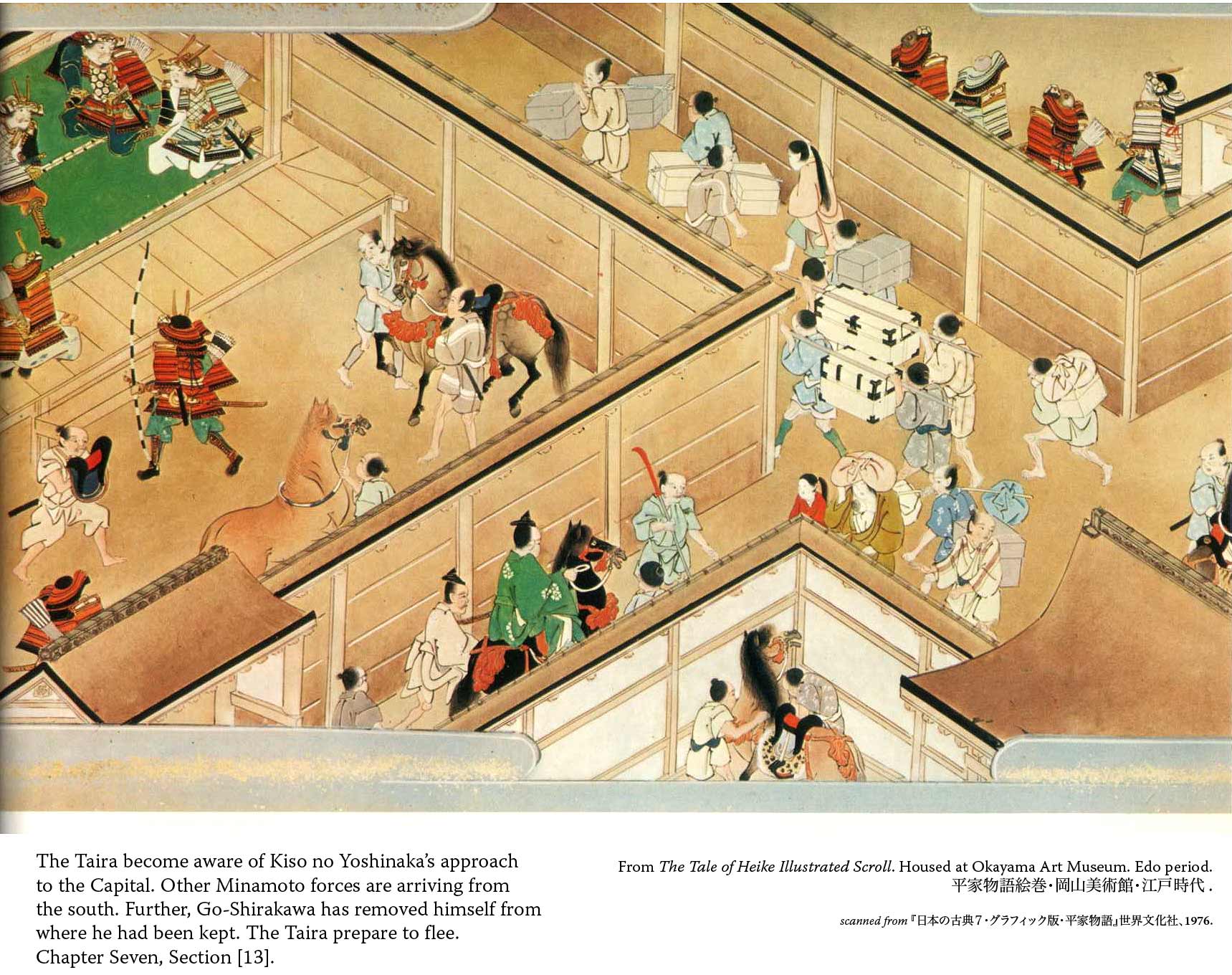
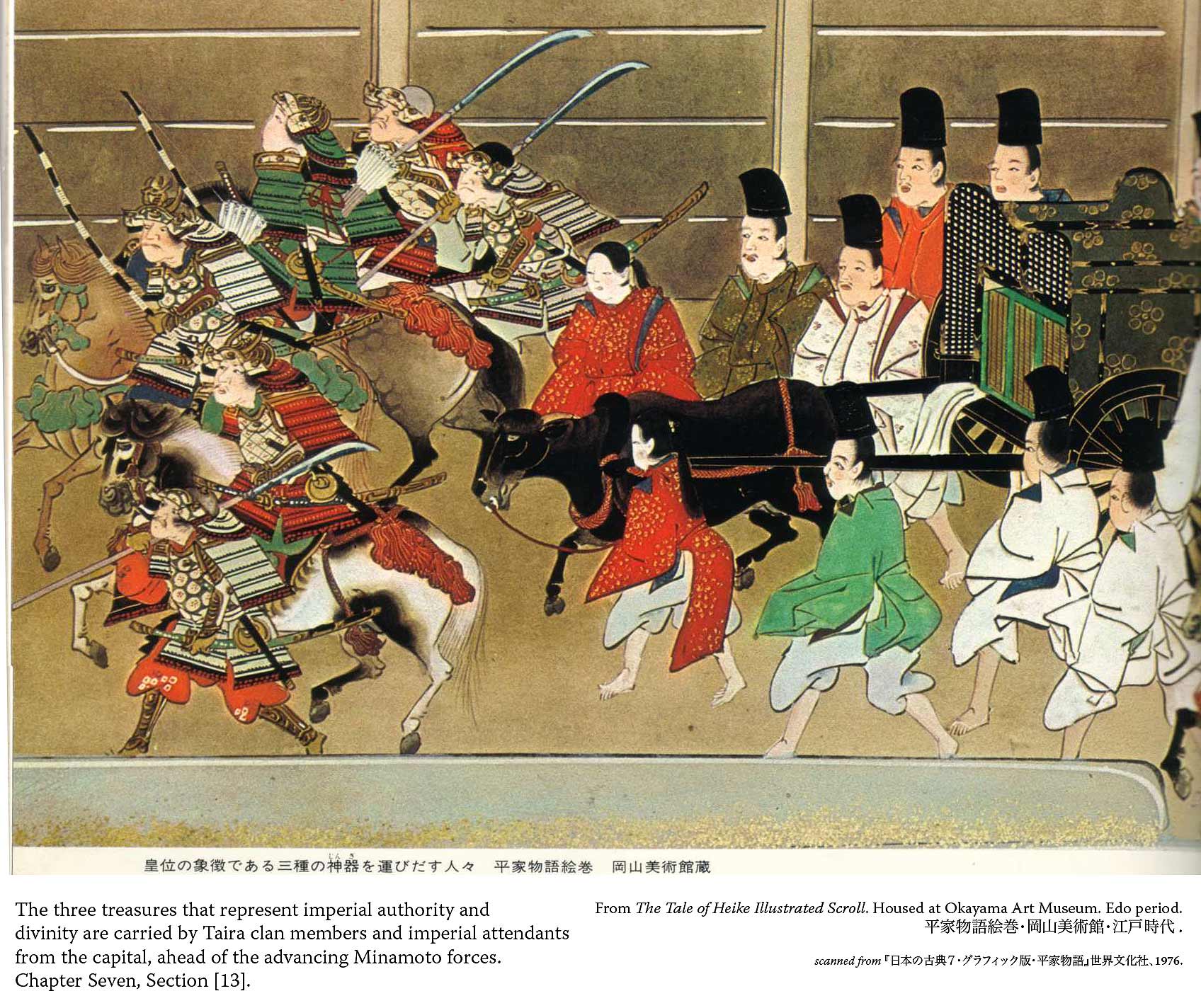
7-[14] Koremori's Flight from the Capital --- One by one the major Taira family members are fleeing before the advancing Minamoto.
Character notes
- Koremori, son of Shigemori
- Rokudai, Koremori's eldest son, and so possible patriarchal heir should Munemori, his uncle, and Koremori die.
Section Summary
- Koremori leaves the Capital, but insists that his wife (daughter of the ill-fated Narichika, who allied with Go-Shirakawa against Kiyomori) and children, including 10-year-old Rokudai who will figure later, remain.
- The Taira burn the Capital.
Reading notes
- <244> "Fetters that bind to a world of sorrow!" --- Because they cause attachments to this world, attachments that should be dropped according to Buddhist teaching. Perhaps I am over-reading here, but I feel a waft of death with this sentence, since often when someone is at the point of death, the attending relatives worry that the spirit of the dying person will want to stay behind if s/he is too attached to the onlooking family members.
7-[15] Imperial Visits --- Something of a homage to the lost houses of the burnt Capital as well as a description of the fall of Taira from their best days. The text, showing sympathy for the Taira, describes their compassionate side.
Character notes
- Munemori, Taira clan head
- Tomomori, one of his younger brothers
Section Summary
- Describes some of the houses that have been burned, places once honored with visits by the emperor.
- Munemori commutes the death sentences of three who have served them but who are not Taira, and releases them to the other side.
Reading notes
- <246> "Your souls are in the eastern provinces" --- That is, they can go and join Yoritomo's forces, and live. In Chapter Five, Section [4] "The Fast Courier," after Yoritomo's defeat at Ishibashiyama, which is nevertheless the first skirmish in the Gempei war, they speak in disbelief that the provinces might be turning against the Taira.
7-[16] Tadanori's Flight from the Capital --- Kiyomori's youngest brother, now part of the elder generation of the Taira, takes his leave from the Capital as well, visiting the most famous poet of the day Fujiwara no Shunzei, who, after the war, will begin to compile the Shin Kokinshû (a work different from the poetry anthology, also famous, noted in this section) at the command of Emperor Go-Toba. (His son carries this work to completion.)
Multimedia
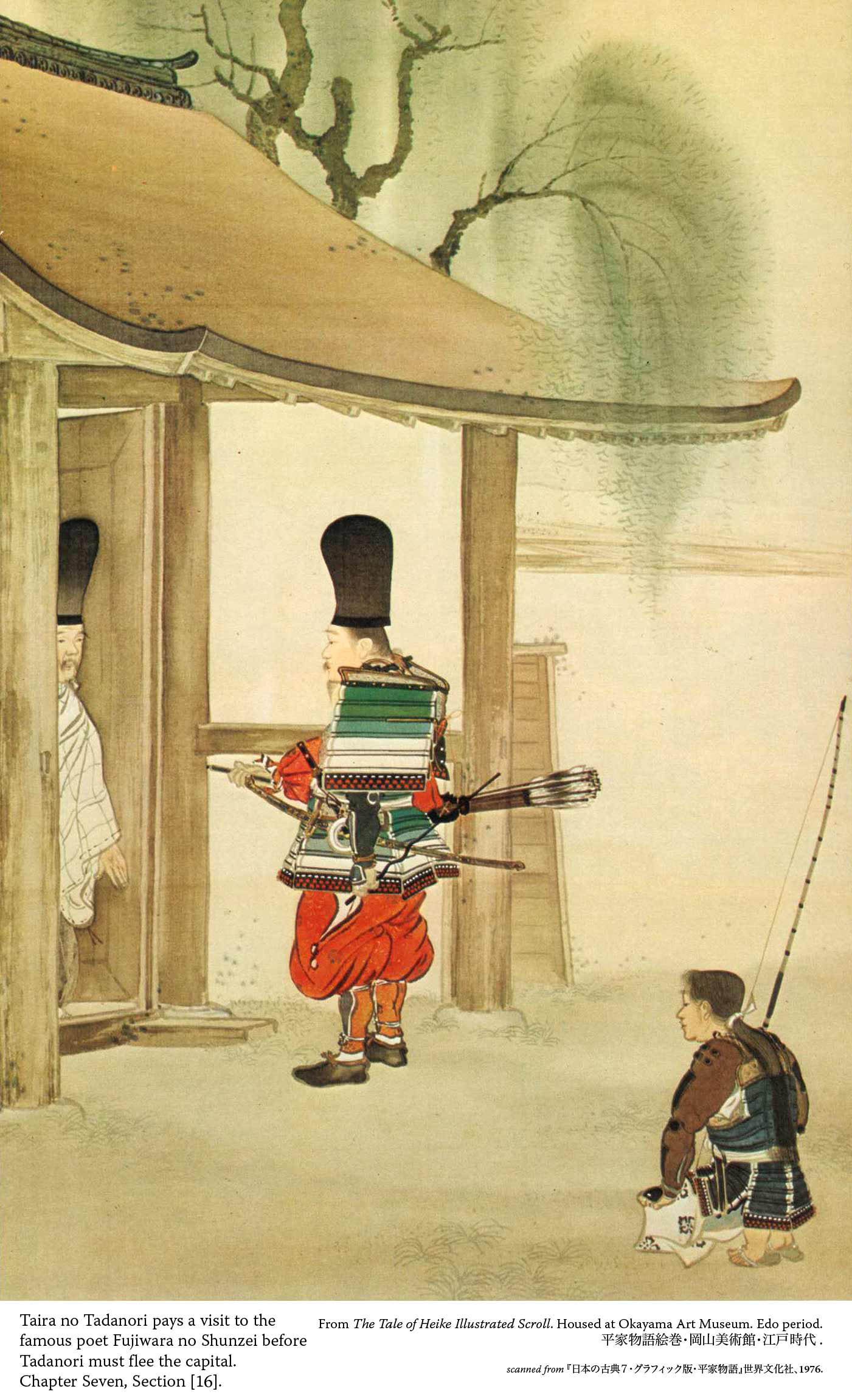
7-[17] Tsunemasa's Flight from the Capital --- Another scene of Capital-parting, this time using music (rather than poetry as in the previous section) as the details that give substance to the story.
Character notes
- Tsunemasa is the eldest son of Tsunemori who is a brother of Kiyomori. (So, he is of Shigemori's generation.) It was this commander in Chapter Seven, Section [3] who paused to visit an island to pray and write poems.
7-[18] Concerning Seizan --- The background of the very special lute (biwa) called Seizan that Tsunemasa received but returns in the previous section, for safe-keeping. This type of instrument was used to accompany the oral performances of telling the Tale of the Heike.
Character notes
- Tsunemasa. See previous section.
7-[19] The Flight of the Heike from the Capital --- A total of 7,000 Taira, all that is left of the clan due to their losses across the country, retreat south. To leave the Capital is essentially to admit defeat; they are now fighting not for control of the country but merely to survive.
7-[20] The Flight from Fukuhara --- The Taira first flee to Fukuhara, the place on the southern coast near present day Kobe that they made the imperial seat of government for barely half a year before returning, under political pressure, to Kyoto. (See Chapter Five, Section [1] "The Transfer of the Capital".)




